Innovations in HR Adopting Agile and Flexible Work Practices

The human resources landscape is transforming, driven by a compelling need for agility and flexibility in the workplace. This evolution is a direct response to the rapidly changing business environment, which is reshaping how organisations manage and support their workforce.
In this transformed environment, adaptability and rapid response are ingrained in the DNA of the workplace. These aspects foster an atmosphere of relentless innovation and collaboration. At the heart of this transformation is the integration of performance management software.
The software facilitates enhanced responsiveness by promoting continuous improvement and real-time feedback. This article explores the critical elements of agile HR and the tools and processes necessary for effective implementation.
Understanding Agile and Flexible Work Practices
In HR, agility is all about embracing adaptability, sparking active participation from every employee, and nurturing a culture dedicated to continuous improvement. It involves encouraging teamwork across different functions and cultivating a culture where feedback is welcomed and promptly addressed. Performance management software is crucial in this evolution, offering a framework for continuous feedback, goal-setting, and performance monitoring.
Workplace flexibility involves creating a space where employees hold the reins—deciding how, when, and where they work. This flexibility can take various forms, such as adjustable working hours, remote work options, job-sharing opportunities, or personalised career trajectories.
Where to Implement Agile in HR Practices
Infusing agility into various HR practices is like adding a secret ingredient to a recipe—it simply transforms the outcome. Here’s a closer look at how agility can revolutionise key areas of HR:
Hiring
Agile hiring adds a breath of fresh air to the recruitment process, making it more efficient, flexible, and collaborative. It breaks down the rigid walls of traditional hiring practices, paving the way for teams from different departments to come together with a common goal: attracting top talent.
This approach prioritises speed and adaptability. Agile hiring also harnesses data-driven insights, tools like applicant tracking systems, and AI for more informed decisions.
OKRs and Goal Setting
Applying agile methodology to OKRs (objectives and key results) and goal setting requires organisations to focus on transparency, collaboration, and adaptability. Setting clear, achievable goals is just the start.
These goals then get transformed into smaller, manageable tasks, making the journey towards achieving them less daunting and more structured. Agile goal-setting also requires a company to utilise data to track progress and make informed decisions.
Onboarding
Agility can result in a more successful onboarding process by creating a flexible, collaborative, and rapid learning environment for new employees. This approach breaks down silos and involves cross-functional teams in supporting new hires.
Organisations should schedule regular feedback sessions and check-ins to continuously refine the onboarding experience. Performance management software will come in handy here by giving firms data-driven insights on individual performance, skill gaps, and training needs.
Implementation Strategies for HR
When introducing new methodologies like agile HR, it’s common for organisations to encounter some resistance initially. This hesitation often stems from the uncertainties and adjustments required for such a transition. To navigate this shift smoothly, firms can embrace the following strategies:
Change Management
Change management is pivotal to adopting agile HR practices. The process should begin with organisations clearly communicating the benefits and rationale behind the shift to agile methodologies.
Companies should ensure that every team member understands not just the ‘what’ but the ‘why’ of these changes. They should develop a strategic plan that outlines the steps for this transformation. The plan will be a roadmap to guide teams through the transition and align everyone with the new direction.
Employee Training and Development
Companies should organise workforce training to develop flexibility, adaptability, and collaboration skills. They should encourage a culture of continuous learning where employees are consistently motivated to acquire new skills and adapt to agile methodologies. This approach will foster an organisational mindset geared towards agility and continuous improvement.
Impact on HR and Organisational Culture
The adoption of agile and flexible work practices brings a significant transformation to HR departments and influences the broader organisational culture. Let’s dive into these impacts:
Transforming HR Operations
Agile practices are revolutionising HR operations, enhancing responsiveness and adaptability. This shift also leads to a more employee-centric approach, which boosts employee engagement and satisfaction. Research from McKinsey & Company supports these claims, showing that successful agile transformations can increase efficiency, employee engagement, and operational performance by around 30%.
When it comes to talent initiatives, agile and flexible practices have been shown to expedite processes with superior outcomes. Another McKinsey & Company report shows that implementing a new regional sourcing strategy could be 75% faster than traditional methods.
Cultivating a Dynamic Organisational Culture
Embracing agile and flexible practices fosters an organisational culture that highly values collaboration, open communication, and a commitment to continuous improvement. Teams evolve to become more cross-functional, effectively breaking down silos and promoting a more cohesive and integrated work environment. Such a culture empowers employees, granting them the freedom and responsibility to contribute meaningfully to the organisation’s objectives.
Technology and Tools
Organisations can benefit from certain technological solutions when implementing agile and flexible work practices. Here are some key tools to consider:
- Performance management software: This software streamlines the process of setting, tracking, and evaluating employee goals and performance. It enables continuous feedback and real-time updates.
- Collaborative platforms: These platforms enable efficient collaboration across different company teams, aligning with the agile ethos of transparency and joint effort.
- Analytics and AI: These technologies offer valuable insights into workforce trends and operational efficiencies, which are essential for strategic HR planning.
The Bottom Line
Embracing agile and flexible work practices in HR is about reshaping an organisational culture to be more adaptive, responsive, and innovative. When organisations implement agile methodologies, they’re not just tweaking processes; they’re setting the stage for remarkable strides in efficiency, innovation, and employee engagement.
They should leverage technology like performance management software but never lose sight of the human element. Remember, this transition is an ongoing process of growth and adaptation. Embrace the change with an open mind and a commitment to continuous improvement.
Author Bio:
Asha A (Senior Content Writer, Profit.co)
In her current role as a Senior Content Writer, she seamlessly merges creativity with strategy, crafting compelling narratives that resonate and drive engagement. With a rich background in content marketing, she has refined her skills to produce insightful pieces that not only captivate audiences but also amplify brands, going beyond traditional storytelling and product marketing.






